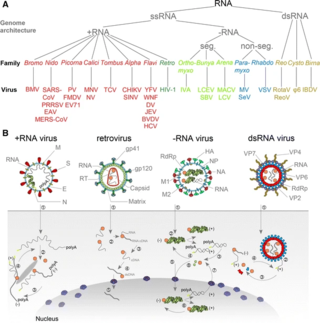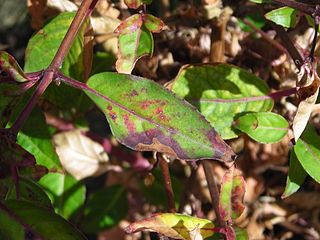
An RNA virus is a virus—other than a retrovirus—that has ribonucleic acid (RNA) as its genetic material. The nucleic acid is usually single-stranded RNA (ssRNA) but it may be double-stranded (dsRNA). Notable human diseases caused by RNA viruses include the common cold, influenza, SARS, MERS, Covid-19, Dengue Virus, hepatitis C, hepatitis E, West Nile fever, Ebola virus disease, rabies, polio, mumps, and measles.

Picornaviruses are a group of related nonenveloped RNA viruses which infect vertebrates including fish, mammals, and birds. They are viruses that represent a large family of small, positive-sense, single-stranded RNA viruses with a 30 nm icosahedral capsid. The viruses in this family can cause a range of diseases including the common cold, poliomyelitis, meningitis, hepatitis, and paralysis.

Renato Dulbecco was an Italian–American virologist who won the 1975 Nobel Prize in Physiology or Medicine for his work on oncoviruses, which are viruses that can cause cancer when they infect animal cells. He studied at the University of Turin under Giuseppe Levi, along with fellow students Salvador Luria and Rita Levi-Montalcini, who also moved to the U.S. with him and won Nobel prizes. He was drafted into the Italian army in World War II, but later joined the resistance.
Circoviridae is a family of DNA viruses. Birds and mammals serve as natural hosts. There are 101 species in this family, assigned to 2 genera. Diseases associated with this family include: PCV-2: postweaning multisystemic wasting syndrome; CAV: chicken infectious anemia.

Nanoviridae is a family of viruses. Plants serve as natural hosts. There are currently 12 species in this family, divided among 2 genera and one unassigned species. Diseases associated with this family include: stunting. Their name is derived from the Greek word νᾶνος, because of their small genome and their stunting effect on infected plants.

T-cell lymphoma is a rare form of cancerous lymphoma affecting T-cells. Lymphoma arises mainly from the uncontrolled proliferation of T-cells and can become cancerous.
Citrus tristeza virus (CTV) is a viral species of the genus Closterovirus that causes the most economically damaging disease to its namesake plant genus, Citrus. The disease has led to the death of millions of Citrus trees all over the world and has rendered millions of others useless for production. Farmers in Brazil and other South American countries gave it the name "tristeza", meaning sadness in Portuguese and Spanish, referring to the devastation produced by the disease in the 1930s. The virus is transmitted most efficiently by the brown citrus aphid.
Luteovirus is a genus of viruses, in the family Tombusviridae. There are 13 species in this genus. Plants serve as natural hosts. The geographical distribution of Luteoviruses is widespread, with the virus primarily infecting plants via transmission by aphid vectors. The virus only replicates within the host cell and not within the vector. The name 'luteovirus' arises from the Latin luteus, which is translated as 'yellow'. Luteovirus was given this name due to the symptomatic yellowing of the plant that occurs as a result of infection.
Apple stem grooving virus is a plant pathogenic virus of the family Betaflexiviridae.

Impatiens necrotic spot orthotospovirus(INSV) is a plant pathogenic virus of the order Bunyavirales. It was originally believed to be another strain of Tomato spotted wilt virus, but genetic investigations revealed them to be separate viruses. It is a negative-strand RNA virus which has a tripartite genome. It is largely spread by the insect vector of the western flower thrips. The virus infects more than 648 species of plants including important horticultural and agricultural species such as fuchsia, tomato, orchids, and lettuce (especially romaine). As the name implies, the main symptom on plants is necrotic spots that appear on the leaves. The INSV virus infects by injecting the RNA the virus contains into the cell which then starts using the cell resources to transcribe what the virus RNA states. Viral infection can often result in the death of the plant. The disease is mainly controlled by the elimination of the western flower thrip vector and by destroying any infected plant material.

Grafting or graftage is a horticultural technique whereby tissues of plants are joined so as to continue their growth together. The upper part of the combined plant is called the scion while the lower part is called the rootstock. The success of this joining requires that the vascular tissues grow together and such joining is called inosculation. The technique is most commonly used in asexual propagation of commercially grown plants for the horticultural and agricultural trades.

Orthotospovirus is a genus of negative-strand RNA viruses, in the family Tospoviridae of the order Bunyavirales, which infects plants. Tospoviruses take their name from the species Tomato spotted wilt orthotospovirus (TSWV) which was discovered in Australia in 1919. TSWV remained the only known member of the family until the early 1990s when genetic characterisation of plant viruses became more common. There are now at least twenty species in the genus with more being discovered on a regular basis. Member viruses infect over eight hundred plant species from 82 different families.
Grapevine virus A (GVA) is a moderately common genetic virus that affects Vitis vinifera and American Vitis grapevine species throughout the world and can be fatal if not treated. Grapevine virus A is in the family Betaflexiviridae and genus Vitivirus. The common name for this virus is grapevine closterovirus. Common symptoms in infected grapevines include stem pitting. Although there is a treatment available to cure infected grapevines, it is not one hundred percent effective, so preventative measures are the best solution to the virus. Every inhabited continent on the globe has had breakouts of grapevine closterovirus due to the complex genetic makeup of the virus. Grapevine virus A has a single-stranded RNA genome, which is similar to that of Grapevine virus B. There are multiple strains of the virus that vary both molecularly and biologically which account for the slightly different symptoms exhibited by infected plants.
Ampelovirus is a genus of viruses, in the family Closteroviridae. Plants serve as natural hosts. There are 13 species in this genus. Diseases associated with this genus include: yellowing and necrosis, particularly affecting the phloem.
Capillovirus is a genus of viruses in the order Tymovirales, in the family Betaflexiviridae. Plants, pome fruits, citrus, and pear serve as natural hosts. There are four species in this genus. Diseases associated with this genus include: abnormal graft union, possibly black necrotic leaf spot disease.
Foveavirus is a genus of viruses in the order Tymovirales, in the family Betaflexiviridae. Plants serve as natural hosts. There are eight species in this genus. Diseases associated with this genus include: mosaic and ringspot symptoms.
The 'Chisel Jersey' is a cultivar of cider apple originating in Somerset.
Grapevine Pinot gris virus (GPGV) is a positive sense single-stranded RNA virus in the genus Trichovirus. It affects the growth of grapevine plants' leaves and fruit, and is similar to grapevine berry inner-necrosis virus.
Apple rubbery wood virus, also known as apple rubodvirus is a viral disease that causes apple rubbery wood in apple and pear cultivars. There are two varieties: ARWV 1 and ARWV 2. It gets its name from its distinctive effect that it has on its host trees, which show unusual flexibility in the stems and branches after a few years of infection. This often results in the maturing fruits of the tree to weigh down the branches such that they lay on the ground. Apple rubbery wood, or ARW, occurs worldwide, affecting apple and pear cultivars in most developed countries.







